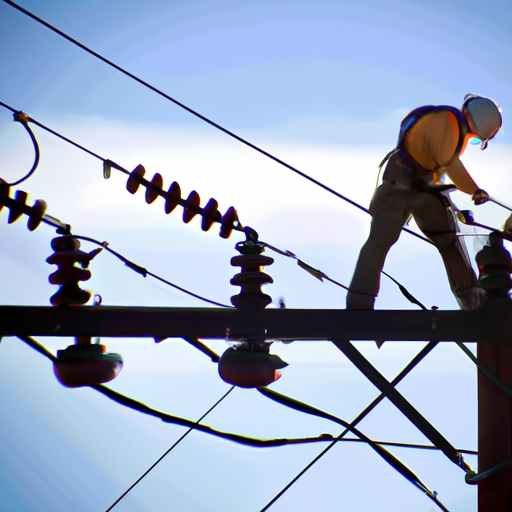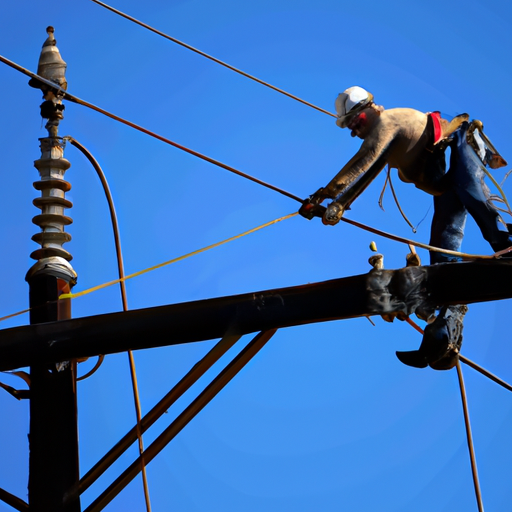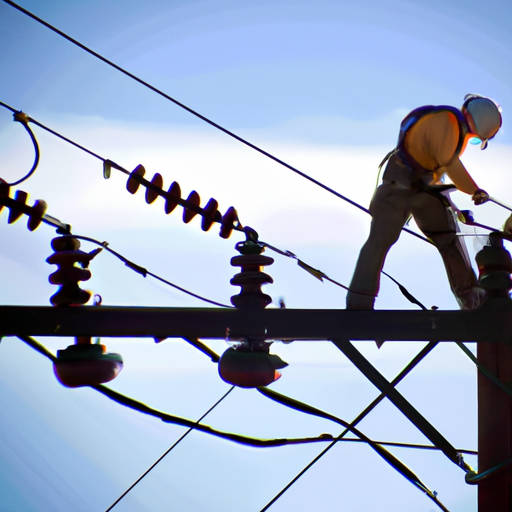Hey there! Have you ever wondered what the most common tasks for lineman repair are? Well, you’re in luck because this article will give you all the information you need. Linemen play a vital role in maintaining and repairing power lines, ensuring that we have electricity in our homes and businesses. But what exactly do they do on a day-to-day basis? In the following paragraphs, we’ll dive into the most common tasks that linemen perform, giving you a closer look at this important profession.
Curious to know more? In the upcoming paragraphs, we’ll explore the various tasks that linemen undertake during their work. From inspecting power lines for damage to repairing broken or faulty equipment, linemen handle a range of responsibilities. We’ll delve into the details of each task, providing you with a comprehensive understanding of the work that linemen do and the skills required to excel in this field. So, if you’re interested in learning more about the most common tasks for lineman repair, keep reading!
Power Line Maintenance
Power line maintenance is essential to ensuring reliable electricity supply to communities. Linemen play a vital role in inspecting, troubleshooting, repairing, and installing power lines and related equipment. In this article, we will explore the most common tasks performed by linemen in their repair and maintenance work.
Inspecting Power Lines
The first and most crucial task for linemen is inspecting power lines. Regular inspections help identify potential issues that could lead to power outages or safety hazards. Linemen meticulously examine power lines for signs of wear and tear, such as rust, frayed wires, or damaged insulators. They also inspect support structures, such as poles and towers, for any signs of instability or damage.
During inspections, linemen use specialized tools and equipment, including binoculars, drones, and thermal imaging devices, to detect any abnormalities. By identifying these issues early on, linemen can promptly address them and prevent potential power outages or accidents.
Replacing Damaged Components
When linemen identify damaged components during inspections or troubleshooting activities, their next task is to replace these components. This could include replacing faulty insulators, damaged wires, or worn-out connectors. Linemen carefully disconnect the damaged components and replace them with new ones to restore the integrity of the power line.
Replacing damaged components requires technical expertise and adherence to safety protocols. Linemen follow specific procedures to de-energize the lines and ensure their own safety while performing these replacements. They also ensure that all connections are secure and properly insulated to prevent future issues.

Trimming Trees Near Power Lines
Another common task for linemen is trimming trees near power lines. Overgrown trees and branches can pose a significant risk to power lines, especially during storms or strong winds. Linemen work closely with arborists to carefully trim branches or remove trees that pose a threat to power line integrity.
Tree trimming requires linemen to work at heights and use specialized tools, such as chainsaws or pole pruners. They must follow safety guidelines to prevent accidents, such as using personal protective equipment and securing themselves using safety harnesses. By trimming trees near power lines, linemen reduce the risk of power outages caused by falling branches or trees.
Troubleshooting and Repairing Power Outages
Linemen are often called upon to troubleshoot and repair power outages. When a power outage occurs, linemen are responsible for identifying the cause of the outage and taking appropriate actions to restore power. This requires a systematic approach and a deep understanding of the power grid.
Identifying the Cause of Outages
The first step in troubleshooting power outages is to identify the cause. Linemen use various techniques, such as visual inspections, testing equipment, and computerized systems, to pinpoint the issue. Common causes of outages include equipment failure, wildlife interference, weather-related damage, or human error.
Linemen rely on their expertise and experience to quickly identify the cause and determine the most effective course of action. They may also coordinate with other team members or utility companies to gather additional information or resources.
Locating Faulty Components
Once the cause of the outage is identified, linemen must locate the faulty components that are causing the interruption in electricity supply. This often involves physically inspecting different parts of the power grid, such as substations, transformers, or circuit breakers.
Linemen use specialized testing equipment, such as voltage detectors and fault locators, to accurately locate the faulty components. They carefully follow safety procedures, such as de-energizing the affected areas, to ensure their own safety during this process.
Repairing Power Grids
Once the faulty components are located, linemen proceed with repairing the power grids. This could involve replacing damaged equipment, fixing faulty connections, or restoring power supply to affected areas. Linemen work in teams to efficiently address the issues and minimize the duration of the outage.
Repairing power grids often requires linemen to work in challenging conditions, such as extreme weather or hazardous environments. They must be skilled in using specialized tools and equipment, such as insulated gloves and hot sticks, to safely handle electrical components. Additionally, linemen must ensure that all repairs comply with regulatory standards and electrical codes.
Installing and Upgrading Power Lines
Aside from maintenance and repair work, linemen also play a crucial role in installing and upgrading power lines. This involves planning power line routes, digging trenches for cable installation, and connecting power line sections.
Planning Power Line Routes
Before installing power lines, linemen carefully plan the routes to ensure efficient and reliable electricity transmission. They consider factors such as terrain, vegetation, and distance to determine the optimal route for the power lines.
Planning power line routes requires linemen to collaborate with surveyors, engineers, and other stakeholders. They also need to comply with regulatory requirements, environmental considerations, and landowner permissions. By carefully planning the routes, linemen ensure the long-term viability and safety of the power lines.
Digging Trenches for Cable Installation
Once the routes are planned, linemen start digging trenches for the installation of power cables. They use specialized machinery, such as excavators or trenchers, to excavate the trenches according to the required specifications. Linemen pay close attention to depth and alignment to ensure proper cable installation.
During this process, linemen must also take into account any existing utilities or underground infrastructure to avoid damage or interference. They work with utility companies or municipal authorities to obtain accurate information about the location of other utilities.
Connecting Power Line Sections
After the trenches are prepared, linemen proceed with connecting different sections of the power lines. This involves carefully attaching cables, insulators, and connectors, and ensuring proper grounding and insulation.
Connecting power line sections requires linemen to work at heights, using specialized tools and equipment, such as bucket trucks and lineman’s climbers. They must follow safety procedures, such as wearing fall protection equipment and minimizing the risk of electrical contact.

Maintaining Electrical Equipment
Aside from the power lines themselves, linemen also maintain various electrical equipment, such as transformers and circuit breakers. This includes testing equipment, replacing faulty components, and cleaning and lubricating parts.
Testing Transformers and Circuit Breakers
Linemen regularly test the performance and integrity of transformers and circuit breakers to ensure they are functioning properly. This involves using specialized testing equipment to measure parameters such as voltage, current, and insulation resistance.
Testing transformers and circuit breakers requires a thorough understanding of electrical systems and equipment. Linemen follow specific procedures and safety protocols to prevent accidents and ensure accurate test results. Any abnormalities or deficiencies detected during testing are promptly addressed to prevent potential failures or outages.
Replacing Faulty Equipment
If linemen identify faulty equipment during inspections or testing activities, their next task is to replace these components. This could include replacing defective transformers, malfunctioning circuit breakers, or damaged surge arrestors.
Replacing faulty equipment requires technical expertise and adherence to safety protocols. Linemen follow specific procedures to de-energize the equipment, isolate it from the power grid, and replace it with new equipment. This ensures the reliable and safe operation of the electrical system.
Cleaning and Lubricating Parts
To maintain optimum performance, linemen clean and lubricate various parts of electrical equipment. This includes removing dust and debris, applying appropriate lubricants, and inspecting for any signs of wear or corrosion.
Cleaning and lubricating parts is a preventive maintenance measure that helps extend the lifespan of the equipment and ensure its proper functioning. Linemen carefully follow manufacturer’s instructions and safety guidelines to perform these tasks effectively.
Safety and Emergency Response
Safety is paramount in the work of linemen. They constantly prioritize their own safety and the safety of their team members and the general public. Additionally, linemen are often called upon to respond to emergency situations, such as storm damage or accidents.
Working at Heights Safely
Linemen frequently work at heights while inspecting, repairing, or installing power lines. They are trained in proper fall protection techniques and use personal protective equipment, such as harnesses and safety helmets.
Implementing safe work practices while working at heights helps prevent accidents, injuries, or fatalities. Linemen are trained to be aware of their surroundings, secure themselves using appropriate anchorage points, and maintain constant communication with their team members.
Implementing Lockout/Tagout Procedures
Before performing any maintenance or repair work, linemen implement lockout/tagout procedures to ensure the equipment is de-energized and safely isolated. Linemen attach locks or tags to energy sources and follow specific procedures to disable or disconnect the equipment.
Implementing lockout/tagout procedures is critical to preventing electrical accidents or electrocution. Linemen undergo comprehensive safety training to understand and adhere to these procedures to protect themselves and others.
Responding to Storm Damage
During severe weather events, such as storms or hurricanes, power lines and electrical equipment are often subject to damage. Linemen play a crucial role in responding to storm damage and quickly restoring power to affected areas.
Linemen work in collaboration with other emergency response teams, such as first responders or utility company personnel, to assess the extent of damage and prioritize repair work. They often work under challenging conditions, such as strong winds or flooded areas, to ensure the safety and timely restoration of power.
Using Specialized Tools and Equipment
Linemen heavily rely on specialized tools and equipment to perform their tasks safely and effectively. This includes operating bucket trucks, using pole climbing techniques, and utilizing line tensioners.
Operating Bucket Trucks
Bucket trucks, also known as aerial lifts, are extensively used by linemen to access power lines at heights. These trucks are equipped with extendable booms that enable linemen to reach elevated locations safely.
Linemen undergo specific training to operate bucket trucks and ensure their safe use. They must follow safety guidelines, such as wearing fall protection equipment and being aware of electrical hazards while operating these trucks.
Using Pole Climbing Techniques
In situations where bucket trucks are not accessible, linemen rely on pole climbing techniques to reach power lines at heights. They use specialized spikes attached to their boots, known as climbers, that allow them to ascend and descend utility poles.
Pole climbing is a skill that linemen develop through extensive training and practice. They must have significant physical strength and coordination to safely navigate and work on utility poles.
Utilizing Line Tensioners
Line tensioners are used by linemen to adjust the tension in power lines for optimal performance. These devices ensure that power lines are properly aligned, secured, and can withstand weather conditions or unexpected loads.
Linemen use line tensioners to string or sag power lines accurately, maintain proper conductor tension, and ensure line stability. They carefully follow manufacturer’s instructions and safety guidelines to prevent accidents or damage.
Collaborating with Team Members
Linemen rarely work alone. Collaboration and effective communication within the team are essential to ensuring efficient and safe repair and maintenance work.
Coordinating Tasks with Crew Members
Linemen coordinate their tasks with other crew members to ensure all necessary activities are performed effectively and in a timely manner. They assign responsibilities, communicate priorities, and provide support to each other as needed.
Effective coordination among team members helps minimize downtime and ensures optimal utilization of resources. Linemen rely on clear communication and teamwork to complete repair and maintenance tasks efficiently.
Communicating Efficiencies and Challenges
Linemen regularly communicate with their team members to share information, updates, and challenges encountered during repair or maintenance work. This includes reporting any issues or deficiencies identified during inspections, sharing best practices, or requesting assistance when facing complex tasks.
By fostering open and effective communication, linemen promote a collaborative work environment where ideas and experiences are shared. These interactions contribute to continuous learning and improvement within the team.
Promoting Safety Culture
Safety is a shared responsibility among all team members. Linemen actively promote a safety culture by adhering to safety protocols, identifying potential hazards, and reporting any safety concerns.
Linemen conduct regular safety meetings, trainings, and drills to ensure all team members are equipped with the necessary knowledge and skills to work safely. They also encourage safety-conscious behaviors and hold each other accountable for maintaining a safe work environment.
Maintaining Records and Documentation
Accurate records and documentation are crucial in the power line maintenance field. Linemen are responsible for recording maintenance activities, documenting repairs and upgrades, and updating equipment inventories.
Recording Maintenance Activities
Linemen maintain detailed records of all maintenance activities performed on power lines and related equipment. This includes information such as inspection dates, findings, actions taken, and any noted abnormalities or concerns.
Recording maintenance activities allows linemen to track the condition of power lines over time and identify patterns or recurring issues. It also provides a comprehensive history that can inform future maintenance plans or upgrade decisions.
Documenting Repairs and Upgrades
Whenever linemen repair or upgrade power lines or electrical equipment, they document the specific details of the work performed. This includes information such as the equipment replaced, parts used, and any modifications made.
Documenting repairs and upgrades helps maintain an accurate record of the infrastructure and ensures transparency. It also provides valuable information for future maintenance or repair work.
Updating Equipment Inventories
Linemen are responsible for updating equipment inventories to ensure accurate record-keeping and inventory management. This includes maintaining information such as equipment types, serial numbers, installation dates, and maintenance history.
Updating equipment inventories allows linemen to effectively manage their resources, plan for future upgrades or replacements, and ensure compliance with regulatory requirements.
Adhering to Regulatory Standards
Compliance with regulatory standards and guidelines is of utmost importance in the power line maintenance field. Linemen diligently follow safety guidelines, comply with OSHA regulations, and meet electrical codes to ensure the safety and reliability of electrical systems.
Following Safety Guidelines
Safety guidelines are established to protect linemen and other workers involved in power line maintenance. Linemen meticulously follow these guidelines, such as those provided by the National Electrical Safety Code (NESC) or the Occupational Safety and Health Administration (OSHA).
By adhering to safety guidelines, linemen prevent accidents, injuries, and fatalities. They constantly prioritize safety and take all necessary precautions to ensure a safe work environment.
Complying with OSHA Regulations
The Occupational Safety and Health Administration (OSHA) sets specific regulations and standards for the safety and health of workers. Linemen comply with these regulations, which include requirements for fall protection, electrical safety, and equipment operation.
Compliance with OSHA regulations is essential to maintaining a safe work environment and protecting the well-being of linemen. Linemen receive comprehensive training on OSHA requirements and are regularly updated on any changes or new standards.
Meeting Electrical Codes
Meeting electrical codes is crucial in ensuring the reliability and safety of electrical systems. Linemen follow electrical codes established by local, state, and national regulatory bodies, such as the National Electrical Code (NEC).
Electrical codes specify requirements for electrical installations, equipment, grounding, and much more. Linemen familiarize themselves with these codes and ensure that their work complies with all applicable standards.
Conclusion
The role of linemen in the repair and maintenance of power lines is crucial to ensuring a reliable electricity supply. They perform a wide range of tasks, from inspecting power lines to troubleshooting outages, installing and upgrading power lines, maintaining electrical equipment, and responding to emergencies.
Linemen’s work requires technical expertise, specialized tools, and a strong commitment to safety. Through collaboration, continuous training, and adherence to regulatory standards, linemen contribute to a reliable power supply and the well-being of communities.
Continuous training and skill development are essential to keep up with advances in technology and evolving industry standards. Collaboration among team members helps foster a culture of safety and knowledge sharing. By prioritizing reliable power supply and the safety of themselves and others, linemen play a vital role in maintaining and improving electrical infrastructure.




